This isn’t really “23 skiddoo 2” since we’ve actually already done “53 Skiddoo“, but you get the idea. In Queens, 23rd Street runs from Astoria to Hunters Point, and like most Queens numbered streets is quite long, but what concerns us here is the stretch of 23rd that runs underneath the #7 El: thousands of people ride along 23rd every day, but very few actually see it…
23rd Street’s el runs through Hunter’s Point, one of Queens’ oldest neighborhoods and perhaps the one with the most varied, fascinating architecture. (We’ll pursue that further on an upcoming Forgotten NY page.) The el was constructed in 1915 and connected to the much older William Steinway tunnels under the East River, which were originally built for trolleys; money and politics, the usual suspects, delayed their use for a couple of decades. As we’ll see, of all the streets in the region, 23rd was an unfortunate choice to run an el (I think Van Alst Avenue, now 21st Street, would have been better) but the presence of the el does provide interesting pictures, at the very least.
According to Forgotten Fan Ken Buettner, “the geography of the area dictated the el’s placement: the el had to be over 23rd Street, and could not have been above 21st Street. The tracks leave the Steinway Tunnel at Hunterspoint Ave., which is already east of 21st Street. Additionally, it was intended to have a 90 degree turn right into the line coming over the Queensboro Bridge from the 2nd Avenue el. (If you look closely at the steel structure you can see exactly where the two lines were merged onto the one track.)”
WAYFARING MAP: 23rd STREET
(amusingly, Google Maps still shows St. John’s Hospital, which was razed so that Hunter’s Point’s biggest landmark, the 45-story Citigroup Building, could be built from 1988-1990!)
Casting a glance down tree-lined 45th Avenue does it no justice, especially in summer; you have to walk west to truly appreciate the landmarked Hunters Point Historic District, mainly built in the 1870s by developers Spencer Root and John Rust; the brownstones once were known, for now unknown reasons, as “the 40 Thieves.”
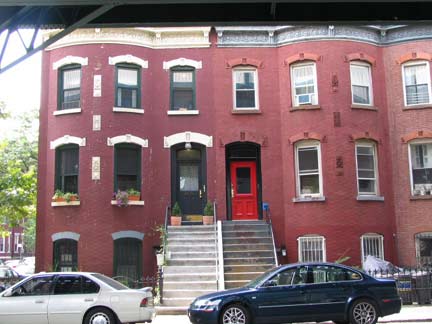
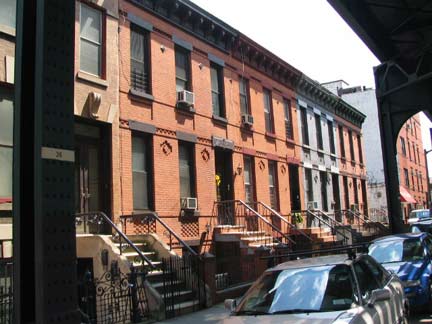
What many el riders may not realize is that a short stretch of landmarked brownstones can actually be found along 23rd Street as well as a collection of handsome, though not yet landmarked ones on the opposite side.
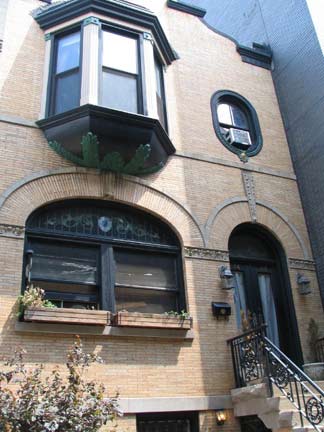
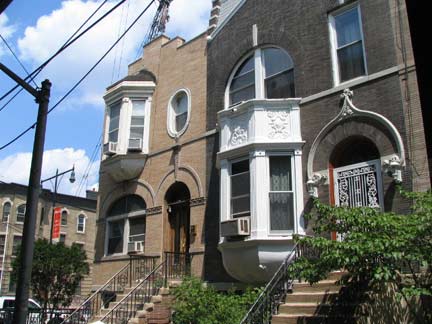
The AIA Guide doesn’t discuss them, and there’s noArchitectural Guide to Queens, but these 1880s-era homes on the eastern side of 23rd are incredible; I still think they ought not to be enshrouded by an el, yet the shadowplay created by the el imparts a charm of its own. But the air conditioner stuck in the little window above the door doesn’t.
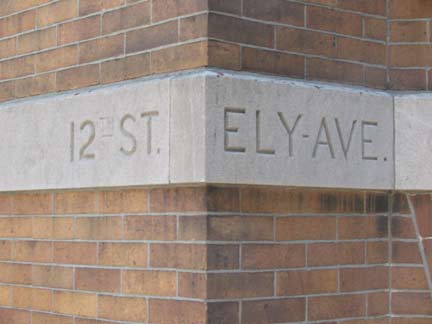
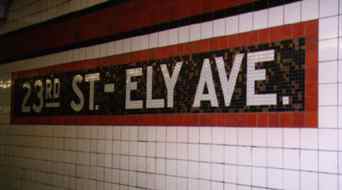
23rd Street has not been called Ely Avenue (nor 45th Avenue 12th Street) since the 1920s, but Ely (pronounced e-lie) is remembered by a corner sign and the nearby IND subway station.

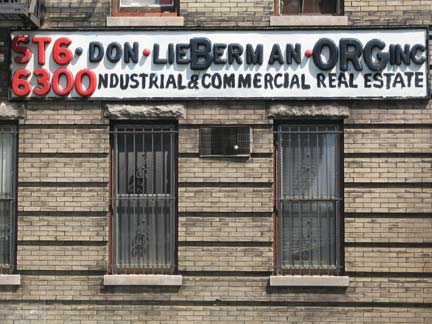
The Don Lieberman Organization has been here at 23rd and 44th Drive for quite awhile, apparently, as the telephone exchange ST6-6300 would attest. The ST stood for STillwell.

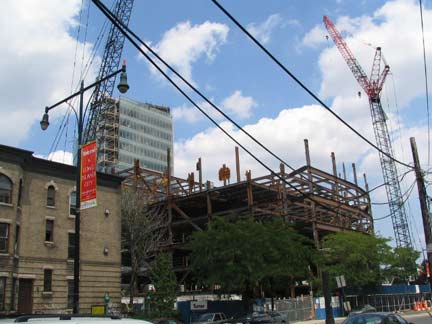
![]() 44th Drive, seen here from each side of the el, is wider than the other avenues in the area, and might have been widened in the 1930s when the IND subway was built underneath it, though there seem to be old buildings on both sides. Prior to the 1920s it was called Nott Avenue.
44th Drive, seen here from each side of the el, is wider than the other avenues in the area, and might have been widened in the 1930s when the IND subway was built underneath it, though there seem to be old buildings on both sides. Prior to the 1920s it was called Nott Avenue.
Forgotten Fan Ken Buettner writes:
44th Drive was always that wide. Note the construction of the original el station, from 1915, which spans the two lanes of traffic in each direction on 44th Drive.
The large glass-walled building going up is the new companion to the massive green 45-story Citigroup tower called Court Square Two (after the el station that serves it, 45th Avenue-Court Square, and the massive Beaux-Arts Queens County Court House building located there; the Citigroup tower is being redubbed Court Square One.
I was intrigued by the horses with horns on the union hall at 21-42 44th Drive, but it dawned on me these were not horses but elk, and sure enough, if you squint you can see the faded BPOE (Benevolent and Protective Order of Elks) on the facade.
Ken Buettner:
The former home of the Benovelent and Protective Order of Elks, Lodge #878, on 44th Drive was abandoned in favor of their newer and more elegant home on Queens Boulevard in Elmhurst somewhere in the 1920’s or so. Unfortunately, most fraternal oraganizations have fallen on difficult times and have lost their buildings. This is also the case of the lodge hall on Queens Boulevard. A deal was made to sell it to a Church which allows the Elks to meet in a small portion of their once massive home.


Next door is DaGianni’s, formerly La Triomphe. It had some marvelous trompe l’oeil of people apparently seated within but it was too high to be really effective.
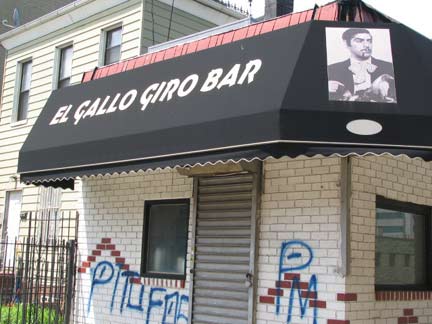
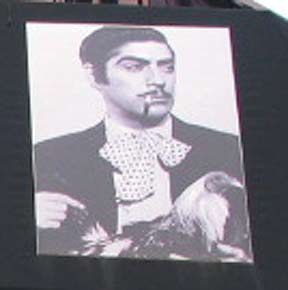
Corner 23rd Street and 44th Drive. Now, you got me here. Is this a pop culture figure? Forgotten Fan Rafael Vallin writes:
The picture above the door of the guy holding the rooster is of a very famous Mexican actor and mariachi singer called Joge Negrete. He was famous from around the late 30’s to the mid 50’s when throat cancer finally killed him. He was a famously a heavy smoker and drinker and a major screen idol in his time.
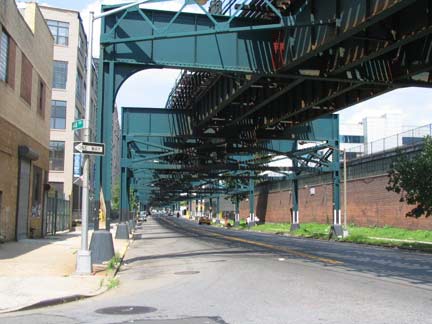
Between 44th Drive and Bridge Plaza (a fascinating tangle of el and highway tracks) 23rd Street is rather more nondescript, though it goes past some old Eagle Electric factory buildings; if you walk over to 22nd Street, you will find Silvercup Studios.

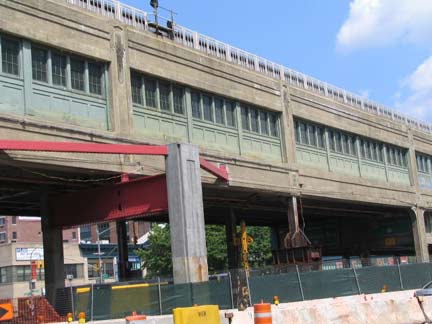
As massive as the Queensborough Plaza el station may be today, it’s only half the size it once was: the Second Avenue El stopped running here in 1942, with its part of the station removed in 1949.
The el station at Queensbridge Plaza (the old name of the current Queens Plaza North or South) had been double in its width. The existing four -track portion (two upper and two lower) is the remaining southern portion. The mirror four-track portion (two upper and two lower) stood over the Manhattan-bound auto traffic. It was a major hub. Some trains from Flushing continued over the Bridge to the 2nd Avenue el. Other trains from Flushing continued above 23rd Street and went into Times Square via the Steinway Tunnel. Still other trains reversed out of the station and took the el to Astoria! Likewise, the Astoria line trains continued into the tunnel to 59th Street, or reversed out and went to Flushing. Again, a careful look a the steel structure of the Astoria line as it begins up Northern Boulevard or of the Flushing line as it runs above Queens Boulevard (and above the Sunnyside Yards) will show you where tracks ran up or down to places which are long-gone.
The windows on the lower level trackways facing the south side of Queens Plaza are still the originals (they were replaced on the north side) as well as the unusual fencing on the top level. This is also one of the few BMT-IRT track crossovers in the NYC subway system. This is a legacy of the joint BMT-IRT operation both the Flushing and Astoria lines featured until 1949. The terra cotta ornamentation can also be found on other concrete viaducts on both the IRT and BMT built during this period; this station opened in April 1917.
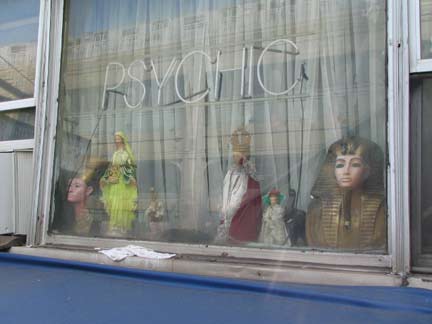
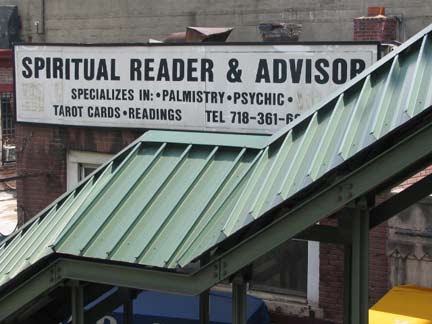
You won’t find Nefertiti and King Tut on the same bill with the Virgin Mary anywhere else but a psychic’s office. This is on the ramp to the Queensborough Plaza station near 27th Street.
[By 2010 these buildings had been razed as part of ongoing Queens Plaza renovations]
Photographed July 30, 2006; page written August 12, 2006

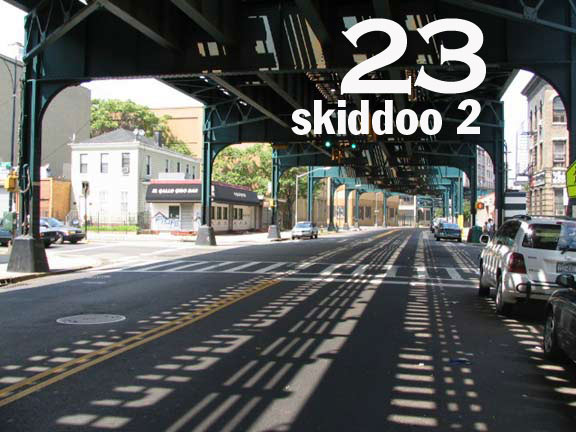
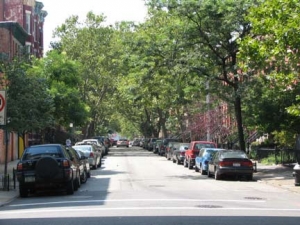
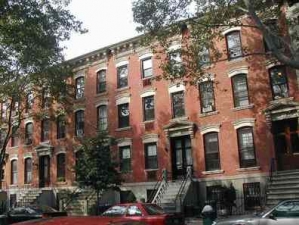
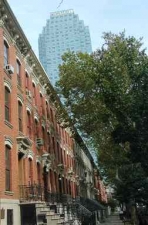
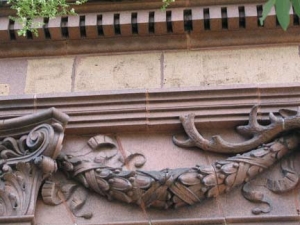
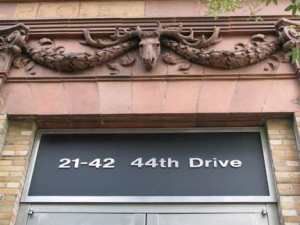
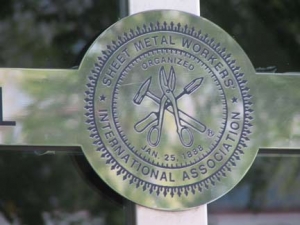
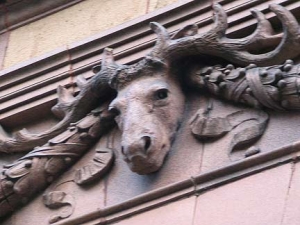
1 comment
After the Elks moved to Elmhurst in late 1924 they sold the Nott Ave (44th Drive) building to Colon Council No. 309, Knights of Columbus – a catholic fraternal organization. Colon 309 was the first K of C Council established in Queens County (February 11, 1898). It was a perfect quarters for another fraternal organiation. There were bowling alleys in the basement, a members Lounge, Library and taproom (despite prohibition) on the main floor, a grand meeting/events hall on 2nd floor, and rooms for visiting members on the 3rd floor. During the 1950-60’s I visited the building as a child with my Dad (who was a member) so I remember the interior layout quite well. Colon Council sold this building in1969 and moved to a smaller building on 20th Avenue off Steinway (the former Chick’s Tavern) in 1970. I am adding this comment now because I read earlier this week that City DOB permits have been issued for the building’s demolition – I guess they call that progress.